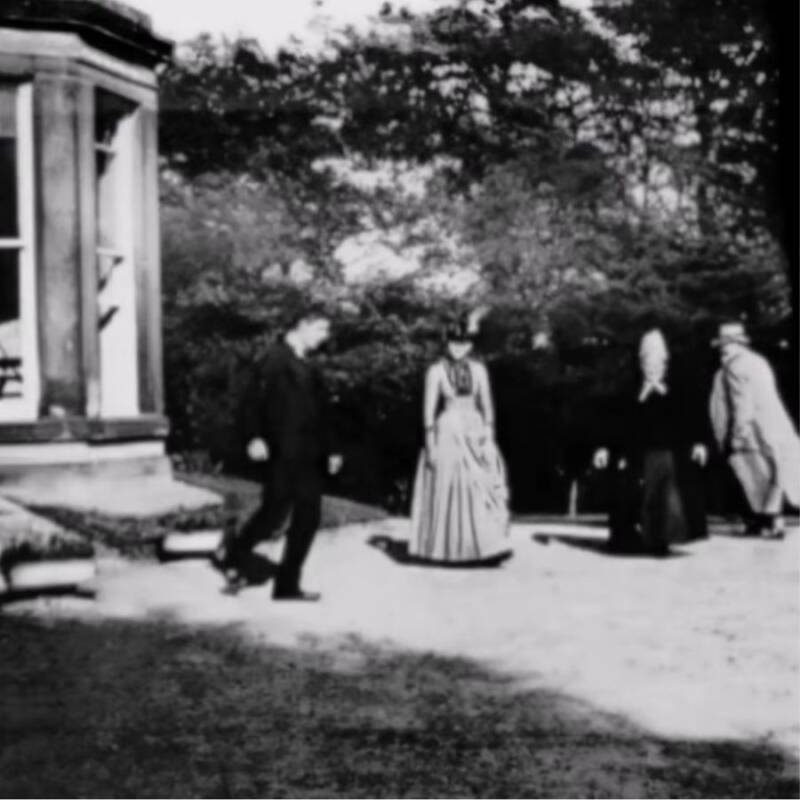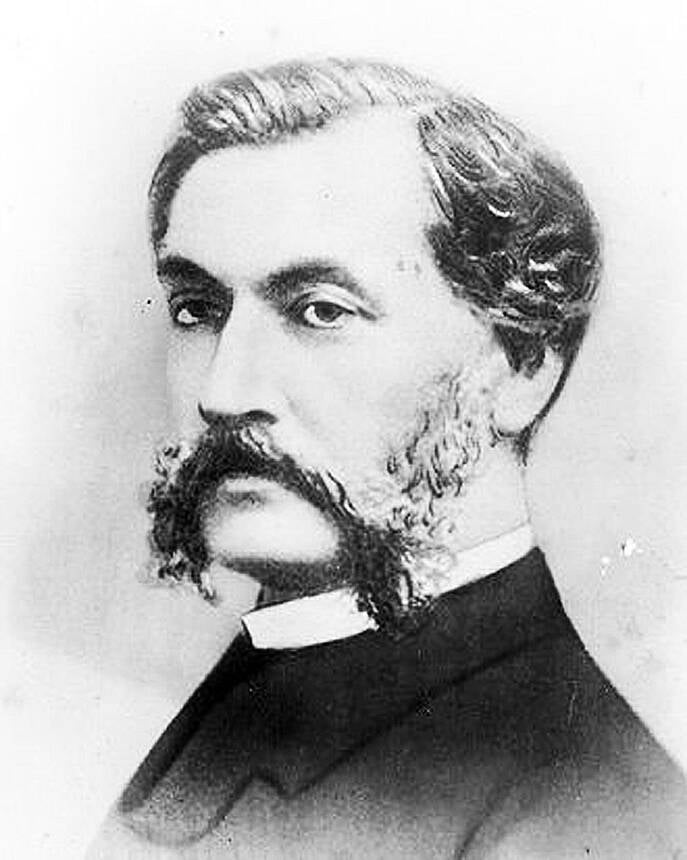Although some historians credit The Horse in Motion or Arrival of a Train as the first movie ever made, Louis Le Prince's 1888 film Roundhay Garden Scene is widely considered to be history's oldest motion picture.

Public DomainA still from Roundhay Garden Scene.
Motion pictures have been one of the world’s favorite pastimes since their advent more than a century ago. From 1939’s Gone with the Wind to Avatar‘s domination of the box office in 2009, viewers have been flocking to theaters for decades to see the latest and greatest films. But what was the first movie ever made?
The answer to that question is debatable. Much of it ultimately comes down to technical definitions of cameras and motion pictures. However, experts have largely agreed that Roundhay Garden Scene was probably the first movie in history.
Filmed in October 1888 by Louis Le Prince using a single-lens camera he’d invented, Roundhay Garden Scene is just 2.11 seconds long and features four people walking in a circle outside of a home in Leeds, England. It’s not a feature film by any means, but it was groundbreaking for its time.
However, before Le Prince could show his movie in public, he mysteriously vanished. Thomas Edison went on to patent the kinetograph and became known as the father of the motion picture, leaving Le Prince’s name forgotten to history.
Some even say Edison had something to do with Le Prince’s disappearance.
Louis Le Prince, The Inventor Of The First Movie Camera
Louis Le Prince was born in Metz, France, on Aug. 28, 1841. His interest in photography likely started at an early age, as he often spent time in the studio of his father’s friend, Louis Daguerre. (Daguerre was the inventor of the early daguerreotype photo process, though the first photo ever taken was produced by his colleague, Joseph Nicéphore Niépce.)

Wikimedia CommonsLouis Le Prince, inventor of the first movie camera.
Later, after studying painting and chemistry in college, Le Prince got a job at a brass foundry. The factory was owned by Joseph and Sarah Whitley, and Le Prince ended up falling in love with and marrying their daughter, Elizabeth. The couple founded the Leeds Technical School of Art, developing a technique in which they fixed photographs onto metal and ceramic pieces.
In the early 1880s, Le Prince invented a 16-lens camera in his attempt to do the unheard of: capture moving pictures. It ultimately failed as a movie camera because the frames didn’t line up quite right when put together, as they all were shot from slightly different angles.

Wikimedia CommonsLouis Le Prince’s 16-lens camera.
Soon after, Le Prince came up with the single-lens camera that he used to record Roundhay Garden Scene. Encased in a large mahogany wood box and weighing in at 40 pounds, the camera was equipped with a hand crank to move the Eastman’s paper negative film across the lens. It was heavy and cumbersome — but it managed to capture the first movie ever made.

Wikimedia CommonsThe first single-lens moving picture camera, patented by Louis Le Prince in the U.K. on Nov. 16, 1888.
‘Roundhay Garden Scene’: The First Movie Ever Made
The whimsical clip of Louis Le Prince’s wife’s parents, his adult son Adolphe, and family friend Annie Hartley may be short — but it’s a significant part of film history.
Le Prince filmed the scene at Oakwood Grange, the home of Joseph and Sarah Whitley, located in Roundhay, Leeds, England. In the two-second clip, Annie, Adolphe, and the two Whitleys prance around in a circle, staying in view of the stationary camera.
Adolphe Le Prince later said that the film was shot at 12 frames per second. However, analysis suggests that it was likely shot at seven frames per second.
Sadly, just 10 days after her joyful romp into modern film history, Sarah Whitley died at the age of 72. Though tragic, the Oct. 24, 1888 written on her death certificate cements the timeframe in which the first movie ever made was filmed. It’s impossible that it was recorded after the date of her death.
However, Whitley’s seemingly unexpected demise wasn’t the only tragedy surrounding Roundhay Garden Scene.
The Mysterious Disappearance Of Louis Le Prince
With Roundhay Garden Scene holding the exclusive title of the first movie ever made, it begs the question of why Louis Le Prince is not a household name. That’s due to his mysterious — and untimely — disappearance.
Le Prince was set to hold the first public screening of his film in New York City in late 1890. Before traveling to the United States, however, he paid a visit to his brother, Albert, in France. Le Prince supposedly boarded a train in Dijon in September 1890 — and he was never seen again. Police recovered no body, and Le Prince’s belongings disappeared along with him.
Naturally, there are many theories about what happened to Louis Le Prince. Some say he died by suicide due to financial struggles, while others claim his brother killed him after they argued about their late mother’s will.
Then, there are those who believe that Thomas Edison had him murdered to eliminate his competition in the world of motion pictures. Le Prince’s widow even upheld this theory, according to the BBC.

Public DomainThomas Edison invented the kinetograph, an early video camera, and the kinetoscope, a device with which to view the captured film.
But things only got more suspicious from there. Edison went on to create his own movie camera, the kinetograph, in the early 1890s. Then, in 1898, the inventor sued the American Mutoscope and Biograph Company on the grounds that they were infringing on his creation.
Adolphe Le Prince appeared in court as a witness for the film company, providing evidence of his father’s work to prove that Edison wasn’t the original inventor of the movie camera at all.
Shortly thereafter, Louis Le Prince’s son was fatally shot while duck hunting. The official report ruled his death a suicide — but skeptics believe that’s a little too coincidental. Of course, there is no evidence that Thomas Edison had anything to do with the death of either Le Prince. Still, the theory is tossed around to this day.
Louis Le Prince’s Cinematic Legacy
Although Louis Le Prince isn’t as well remembered as Thomas Edison or the Lumière brothers in the history of film, his contribution is no less important.
Before Le Prince, the closest thing the world had to a movie was The Horse in Motion. In 1878, photographer Eadward Muybridge had taken a series of photos of a galloping horse in an effort to determine if the animals lifted all four of their hooves off the ground at once when they ran.
Muybridge projected the images onto a zoopraxiscope disc — a predecessor of the movie projector — to make it look as if the horse was moving. It was similar to a film, but the sequence of photographs was really more like a GIF.

Library of CongressPhotographs from Eadweard Muybridge’s The Horse in Motion.
If Le Prince hadn’t vanished in France, not only would he have held the title of creator of the first movie ever made, but he also would have been the first person to hold a public showing of a film. Instead, that honor went to Auguste and Louis Lumière when they displayed their 46-second motion picture, Employees Leaving the Lumière Factory, at the Grand Café in Paris in 1895.
However, Guinness World Records grants Louis Le Prince and Roundhay Garden Scene the award for the oldest film. Although other big names in cinema history have since overshadowed Le Prince, he can indeed be called the true Father of Cinematography.
After learning about the first movie ever made, read about another instance of someone beating Edison to the punch. Then, find out more about the film world’s first sequels, remakes, and reboots.





